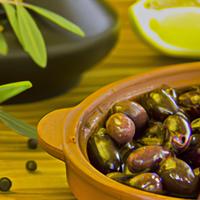
1 serving (15 grams) contains 35 calories, 0.2 grams of protein, 3.5 grams of fat, and 1.0 grams of carbohydrates.

Log this food in SnapCalorie

Nutrition Information
Calories |
555.6 | ||
|---|---|---|---|
% Daily Value* |
|||
| Total Fat | 55.6 g | 71% | |
| Saturated Fat | 7.9 g | 39% | |
| Polyunsaturated Fat | 0 g | ||
| Cholesterol | 0 mg | 0% | |
| Sodium | 3174.6 mg | 138% | |
| Total Carbohydrates | 15.9 g | 5% | |
| Dietary Fiber | 4.8 g | 17% | |
| Sugars | 0 g | ||
| protein | 3.2 g | 6% | |
| Vitamin D | 0 mcg | 0% | |
| Calcium | 158.7 mg | 12% | |
| Iron | 4.8 mg | 26% | |
| Potassium | 158.7 mg | 3% | |
* Percent Daily Values are based on a 2,000 calorie diet. Your daily values may be higher or lower depending on your calorie needs.
Food Attributes
Source of Calories
About Kalamta olives
Kalamata olives, originating from the Kalamata region of Greece, are a staple in Mediterranean cuisine. These dark purple, almond-shaped olives are celebrated for their rich, tangy, and slightly fruity flavor. Packed with heart-healthy monounsaturated fats, Kalamata olives can support cardiovascular health and reduce inflammation. They are also a good source of vitamin E, an antioxidant that helps protect cells from damage. Additionally, they provide small amounts of iron, calcium, and copper. However, like many olives, Kalamatas are typically cured in brine, resulting in a higher sodium content, so portion control is advised for those monitoring salt intake. Whether enjoyed as a snack, in salads, or blended into tapenades, Kalamata olives are a nutritious addition to any diet when consumed in moderation.



